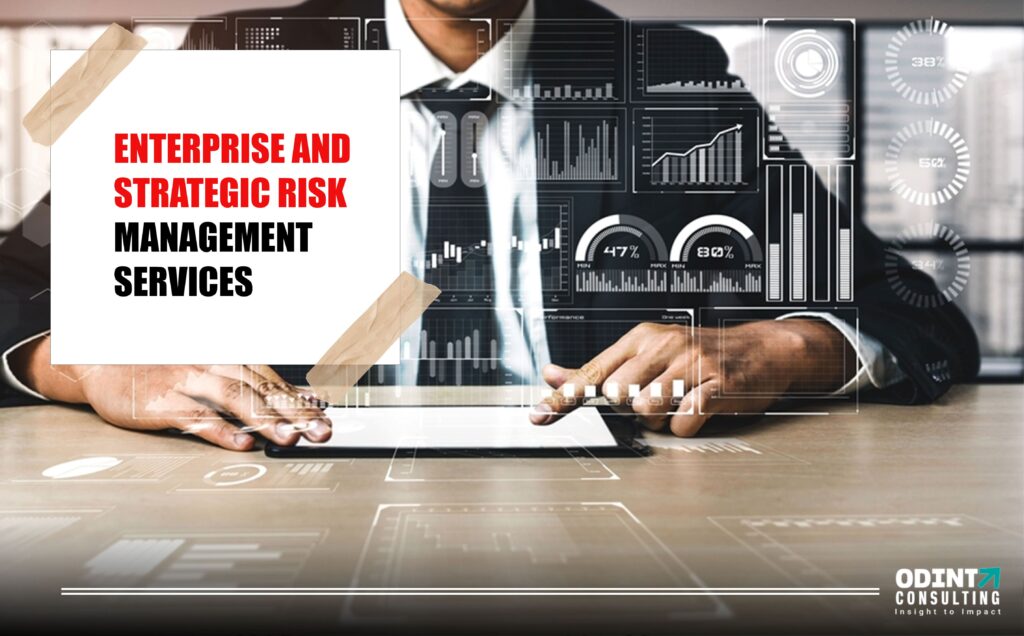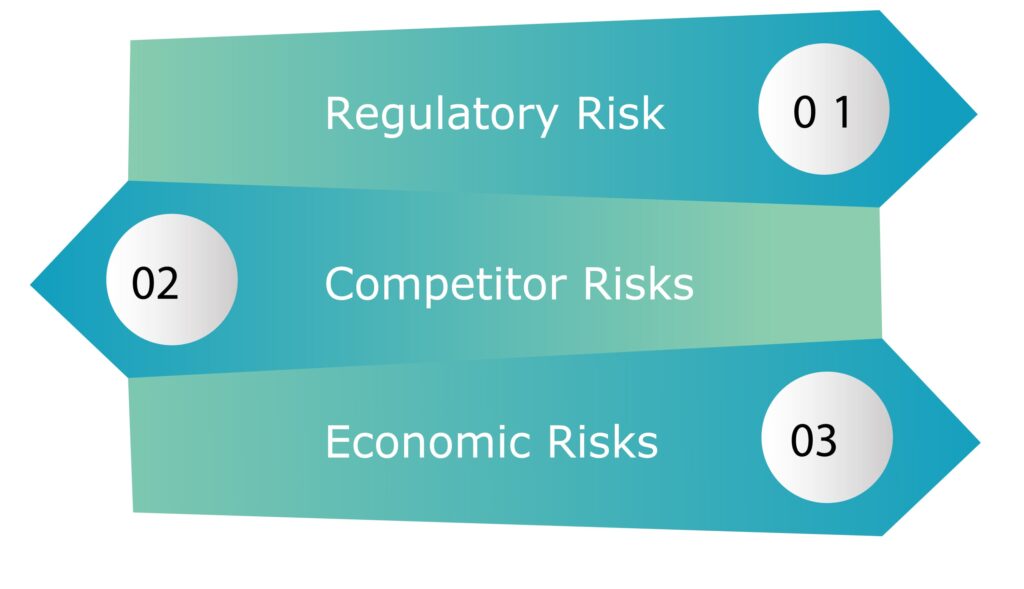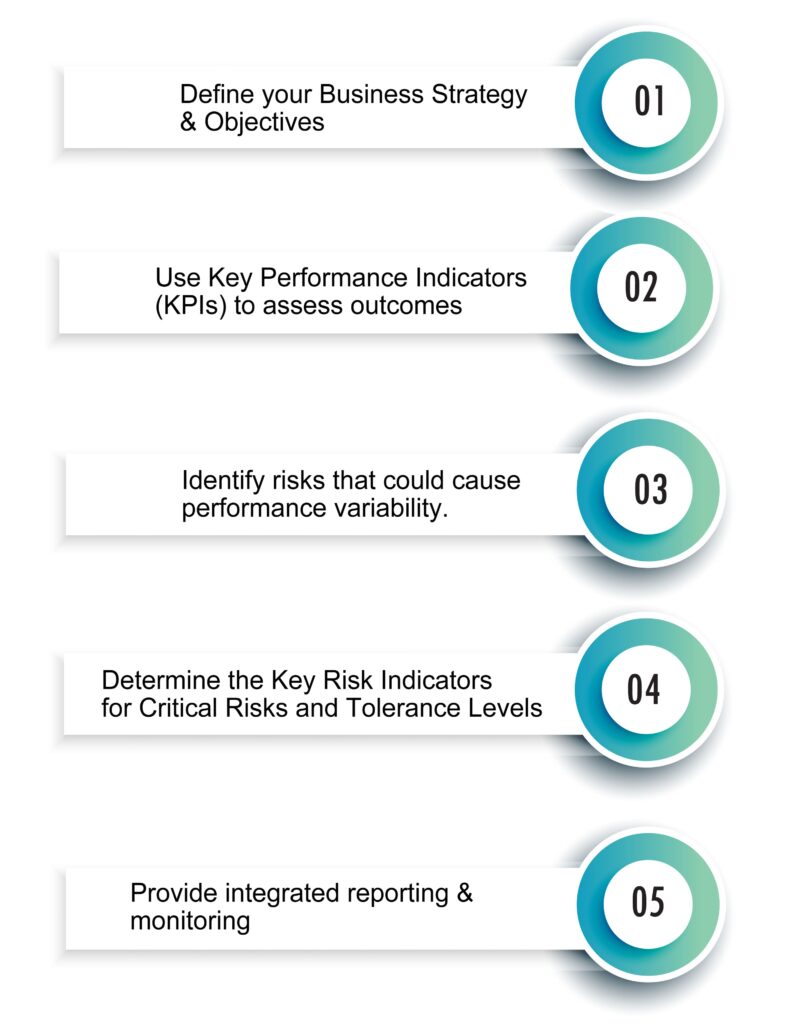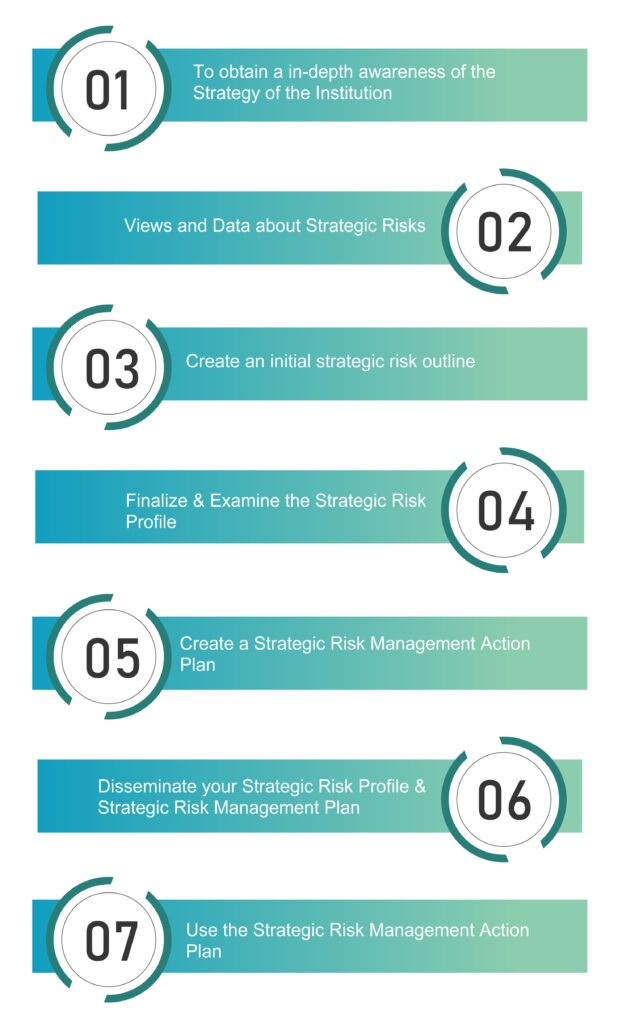
Strategic Risk Management Services
Strategic risk management can be described as a business domain that evaluates the uncertainties & undefined potential that could affect an institution’s protocol or implementation.
The process of identifying and assessing the risks associated with a company’s business strategy is called strategic risk management. It also includes the ability to take action when the risks are realized. Strategic risk management considers all possible outcomes and scenarios, and how they will influence the procedure & its performance.
This has an explicit effect on the firm’s value. All risks are considered, from market risk and product innovation risk to reputational and supply chain risk. As the foundation of enterprise risk management, organizations must explain acceptable risk levels to guide strategic decision-making.
This is a continuous process and must be embedded in both a strategy setting and strategy execution. Any organization can manage enterprise risk. Some risks are related to exposures that, while potentially harmful, do not pose a threat to the enterprise’s overall health or ability to achieve its goals.
Some risks are related to exposures that, while they can be harmful, do not pose a threat to the organization’s overall health. Other important events can cause significant losses and not only affect an organization’s ability to achieve its goals, but also create substantial risks that could be life-threatening.
What is Strategic Risk Management?
The procedure of formulating & managing strategic chances for an organization is called strategic risk management. This can hinder an organization’s potential to accomplish its strategic objectives and create shareholder and stakeholder value.
This is an integral component of Enterprise Risk Management and a necessary foundation. It also contains the laws of risk management.
- It involves the identification, assessment, and management of both internal and external events that could affect the achievement or potential failures of strategic objectives.
- Protecting shareholder value is the main goal.
- It is the foundation of the entire enterprise risk management process.
- It is affected by management, the Board of Directors & different groups.
- You must also have a strategic perspective of threat & assess the potential consequences for the organization’s capability to accomplish its goals.
- It is a continual procedure that is rooted in strategy execution or management.
What Are the Necessary Process to Strategic Risk Management?
The foundation of both management and board-level management is strategic risk management. The maturity level of ERM (Enterprise Risk Management), will determine the exact steps an organization takes. An organization’s maturity level will determine the correct actions it takes.
These are the steps to strategic risk management:
- The maturity of an organization’s ERM efforts relative to its strategic risk is a measure of its maturity.
- Examine the strategy and identify related risks.
- Examine the methods for measuring and monitoring the performance of the organization.
- Establish a process for updating the assessment of strategic risk periodically.
How do you specify strategic risk?
Their is an two characteristics, which are crucial in strategic risk management:
- Understanding the firm, its target audience, market sector, opponents & the atmosphere in which it governs is essential.
- Awareness of the organization’s strategic goals from the beginning to the execution.
It takes time and money to collect data in both these areas, but it is worthwhile to gain the best insights possible into strategic risks. More details can be gleaned. You will be able to implement safeguards and processes that support organizational success.
Another way to identify the risk is to speak with multiple stakeholders to get their opinions on strategic risks. If you confer a large Institution. These people will possess a distinct views than your employees on the organization.
Build a Strategic Risk Management Plan

Your sector, consumer range, product portfolio, and other factors will all impact the strategic risks you face. There are several types of strategic risk.
These are the main types of strategic risks:
Regulatory Risk
Imagine an institution is working on a new product, or a modern assistance to alter the market. Sometimes, it finds a need in the market and creates a solution. The regulations can change over time and suddenly the product or service is unacceptable.
A company that cannot deliver the product or service it has created to its target audience will risk a significant loss in revenue. The company was prepared for any unexpected regulatory changes.
Although, you can combine the project elements into another, or adapt them to provide a different solution. Companies must keep current with all relevant market regulations and be aware of any future changes.
Competitor Risks
Many industries are extremely competitive. If their market competitors release similar products at the same price or lower, the companies could lose ground. If the product is superior, pricing might not matter.
This strategic risk can be mitigated by conducting competitor analysis. Businesses should not operate in isolation.
Economic Risks
Although it is hard to predict the impact of economic risks on your business, they can be a serious threat to any strategy. One example is when the economy changes cause a business’ target audience to lose some disposable income.
Necessary Steps for Strategic Risk Management

To be successful in strategic risk management, five steps must all be included in the strategic planning and execution process.
Define your Business Strategy and Objectives
Companies use a variety of frameworks to plan their strategy. These range from simple analysis to more complex balanced scorecards. These frameworks fail to address risks. This is what is common. Companies must also take extra steps to incorporate risk into their planning stages.
Use Key Performance Indicators (KPIs) to assess outcomes
They can be improved by using the best key performance indicators, which provide clues to the company. The company can find answers by comparing the total sales to the transaction per customer basis.
Identify risks that could cause performance variability.
These unknown issues, like future customer demand, will determine the outcome.
Determine the Key Risk Indicators for Critical Risks and Tolerance Levels
KPIs are historical performance measures, while Key Risk Indicators (or KRIs) are forward-looking indicators that can help you anticipate potential roadblocks. Tolerance levels are triggers for taking action.
Provide integrated reporting and monitoring
Companies must also monitor their results and KRIs regularly to avoid potential risks and seize on unanticipated opportunities.
Procedure for Strategic Risk Assessment

For a comprehensive strategic risk measurements, there were 7 steps:
Step 1:- To obtain a in-depth awareness of the Strategy of the Institution
First, the inspection must verify an obvious insight of the institution’s business goals & strategies. While some organizations have clearly defined strategic plans and objectives they can use to help guide their business decisions, others may be less formal in articulating and documenting the strategy.
This step can help you to establish a foundation for integrating risk management and a business strategy.
Step 2:- Views and Data about Strategic Risks
Next, gather information and view the organization’s strategic risk. Interviews with managers and directors, surveys and analysis are all possible methods. Data gathering should include both outer & inner auditors.
Step 3:- Create an initial strategic risk outline
It is crucial to adjust the culture of the institution with the presentation style and level of detail.
Step 4:- Finalize & Examine the Strategic Risk Profile
It is necessary to create & assess the preliminary strategic risk profile. Validation may include validation with all directors and managers.
Step 5:- Create a Strategic Risk Management Action Plan
Although it is necessary to conduct a thorough risk assessment and create a strategic risk profile, the result must be an action plan that will improve the risk monitoring or take management actions to address the identified strategic risks. The purpose of this process is to improve and help the organization manage and monitor high-rated risks.
Step 6:- Disseminate your Strategic Risk Profile & Strategic Risk Management Plan
Two main goals are required to improve the institution’s culture of risk management.
First, the statement of prime risks within the institution & the strategic risk management plan to understand how to manage them is important.
The communication of management’s expectations about risk will be the second focus. This helps reinforce the message that understanding and supervising harm is a crucial ability for all employees.
Step 7:- Use the Strategic Risk Management Action Plan
Executing a development plan to manage and monitor risk is the main benefit of the risk assessment process. These steps are a high-level procedure that requires a lot of customization and tailoring to fit the company’s capabilities and maturity.
What's the Difference between Strategic Risk & Operational?
To decipher long-term issues, it is crucial to acknowledge & take action on strategic risk. However, operational and strategic risks are very different.
- Both inner and outer forces can extend strategic risks. Operational risks are primarily based on the internal business processes, particularly when they disrupt the workflow.
- You can also say that operational risk is what you do and strategic risk is what you do.
- Second-hand machinery, for example, can cause delays in production and damage employee morale. This is where the operational risk can be caused by a seemingly non-critical problem that can slow down productivity.
How ODINT Consultancy helps organizations with ERM services?
1. ERM Tool Design:
We enable you in building an ERM tool as per your ordinance & industry norms whilst aligning it with the COSO ERM working. The ERM tool enables organizations in creating an extensive ERM Framework and proactively oversee the threats.
2. Documentation of Implementation
We assist you with prepping the principles & procedures of ERM solutions by:
- Detailing & enforcing Risk Management Policy & Procedures;
- Reducing the procedure of identification, inspection & documentation of risks; and
- Putting up a system of rectifying the usefulness of a risk ease plan.
3. Assurance on ERM
One of the crucial regulations of the board is to amass assurance that risk management processes are functioning effectively & that key threats are being regulated to an adequate level. As a basis of ERM audit, we assess
- The productivity & persuasion of the threat acknowledgement;
- The majority of an ERM system ensure the business;
- That the methods are comprehended & obeyed.
In a nutshell, we offer a commitment to the Management & the Board on the all-around ERM system & that there are suitable controls on the spot to mitigate certain risks.
Conclusion
Progressive industries encounter various sets of risks & apt dangers. In the past, firms traditionally handled their threat exposures via each group organizing its own business.
However, companies that employ ERM will generally have a reliable enterprise risk management team that directs the workings of the company.
If you still have any queries related to the Enterprise and Strategic Risk Management Services, we are ODINT Consultancy, here to help you out in each & every step of yours.
FAQ’s
Strategic risk management is crucial because it regulates risks that could considerably effect the firm’s capability to accomplish its enterprise objectives & strategies.
All the methods to manage risk after identifying and assessing them fall into one of the following categories:
- Avoidance.
- Reduction.
- Sharing.
- Retention.
The strategic risk could result from making poor business decisions, insufficient resource allocation or a failure well to adapt to changes in a business environment.
Enterprise risk management is a variant of traditional risk management. Enterprise Risk Management is the management of risk-averse events within an organization.
Here are some key components of a solid enterprise risk management program:
The following are key components of a solid enterprise risk management program:
- Threat Appetite.
- Community, Governance & Policies
- Harmful Data & Infrastructure
- Supervision Environment.
- Ratio & Inspection
- Suspicion Testing & Scenario Planning
Enterprise Risk Management (ERM), is vital because it determines the health and well-being of a business enterprise. An organisation would have a difficult time identifying risks.
ERM frameworks address the risks that an organization faces. An organisation must conduct a SWOT analysis in order to understand an ERM framework.
Before using ERM, it is essential to understand the organisation’s structure. Prior to using ERM, the company should set goals. These goals should be aligned with the development of the company’s goals and objectives.
